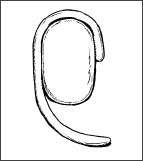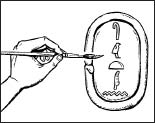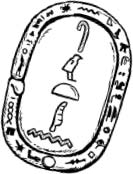Read The Time Travelers' Handbook Online
Authors: Lottie Stride
The Time Travelers' Handbook (12 page)

You land in what looks like a temple, in front of tall sandstone walls that are engraved with lots of pictures. The pictures, which run up and down the walls in straight lines, are hieroglyphsâone of the very first forms of writing.

You spend a moment trying to work out what all the pictures mean, but even though you recognize some of the shapesâsuch as birds and snakesâyou can't make heads or tails of it.
Picture Power
You look around for someone who might be able to help and spot a young man with a partly shaven head walking up the steps of the temple. He has a number of
papyrus scrolls
under his arm. Politely, you ask him to help you understand what the hieroglyphs mean. His name is Suten Anu. He is a scribe at the palace of the pharaoh, the king of Egypt.
Suten tells you that the writing you see on the walls was taught to Egyptians by Thoth, the god of wisdom. Suten believes that the pictures have a power all of their own. It would take years to teach you how to read all of the symbolsâthere are over 700 of themâbut he is happy to give you a few pointers.
Sounds Likeâ¦
Suten Anu unrolls one of his papyrus scrolls that contains a list of the symbols most commonly used in the writing. He explains that all of them stand for sounds. He says each sound as he runs his finger down the list.

He indicates matching pictures on the walls and points out the little strokes that appear underneath some of them. He says if you see a stroke under a sound symbol, it means the symbol also stands for an object. For example:

You notice that aren't any punctuation marks, such as periods or question marks, on his list of symbols. Suten looks at you blankly, and you guess they don't have any.
To make things more confusing, the hieroglyphs can be drawn left to right or right to left, whichever fits the space best.
Cartouche for A King Or Queen
Some hieroglyphs are written in oval frames. These are special ones, known as cartouches. They contain the names of kings and queens. People believe the oval frame protects the royal name.
You ask Suten if he could show you how to write your own name in hieroglyphs. He suggests you start by spelling it out with the sound hieroglyphs he showed you earlier, matching the sounds to the letters in your name. Then you attempt to write his name.

He laughsâit is not quite how he would do it, but he thinks that with practice, you could make a very good scribe.
Make A Cartouche
Why not practice your hieroglyphic writing by making a cartouche of your own name?
You will need:
⢠a sheet of paper and a pencil ⢠self-hardening modeling clay ⢠a dinner knife ⢠a rolling pin ⢠a thin knitting needle or skewer ⢠some paint ⢠paintbrushes ⢠glue
1.
Plan your cartouche on paper first. Use the list on
here
to pick out all the letters in your name and write them out on a piece of paper.
2.
Roll out your clay with a rolling pin, until it is ½ inch thick.
3.
Cut out an oval shape using a dinner knife. (You can make your cartouche any size you like, but 10 inches by 5 inches should fit most names well.)


4.
Make the rest of your clay into a long sausage shape by rolling it between your palms. It needs to be long enough so you can attach it all the way around the edge of the oval you cut out.
5.
Next, carve the hieroglyphs that spell out your name into the clay, using a skewer. Do it lightly first, to check that you can fit your name in. Then, go over your hieroglyphs again, pressing a bit harder.

6.
When you have finished, let the clay dry, or bake it following the instructions on the package.
7.
Paint your cartouche with a coat of yellow paint to make the clay look like sandstone. Then leave it to dry.

8.
When the yellow paint is completely dry, use a thin paintbrush to paint your hieroglyphs in bold colors.
Display your finished cartouche somewhere in your room to alert your family to your royal status. It might make them treat you like a pharaoh, and that is goodâpharaohs were treated like gods!

Warning
Don't make your cartouche while you are in Ancient Egypt. Only gods and royalty had their names in a cartouche, so you could get into trouble.
